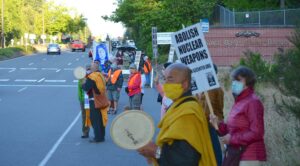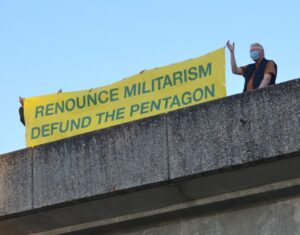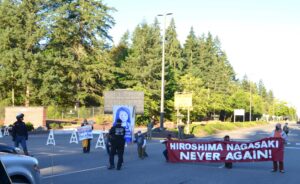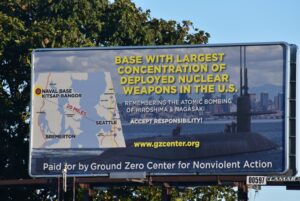by Leonard Eiger
Ground Zero Center for Nonviolent Action remembered the anniversaries of the atomic bombings of Hiroshima and Nagasaki with a silent vigil and nonviolent direct action at the Main Gate of Naval Base Kitsap-Bangor, home to the largest concentration of deployed nuclear weapons in the U.S.
Approximately 25 people gathered at Ground Zero Center for Nonviolent Action early Monday morning, August 10, 2020. After a blessing by Reverend Jessica Starr Rocker of the Kitsap Unitarian Universalist Church and the collective reading of the Pledge of Nonviolence, those gathered walked to the Naval Base Kitsap-Bangor Main Gate, led by Senji Kanaeda and Gilberto Perez, monks from the Bainbridge Island Nipponzan Miyohoji Buddhist Temple.
The group arrived at the Main Gate at 6:45 a.m. and formed a line on the shoulder for a silent witness, with drumming by the monks. Both Washington State Patrol (WSP) and base security were present.
Three people held a banner – “Renounce Militarism Defund the Pentagon” – from the overpass facing incoming traffic.
At approximately 7:05 a.m., four Peacekeepers entered the road to safely stop traffic. Six people then entered the roadway. Larry Kerschner, Bernie Meyer and Michael “Firefly” Siptroth held a banner: declaring, “Hiroshima Nagasaki Never Again”. George Rodkey and Mack Johnson held a “No More Genocide in My Name” banner. Banner holders took a knee, while Rev. Gilberto Perez stood drumming and wearing a Black Lives Matter sign that was carried on the 2020 Peace Walk for a Nuclear-Free World & Black Lives Matter. Traffic was stopped for 5-10 minutes while resisters blocked the roadway.
All those (named above) who participated in the nonviolent direct action by blocking the roadway were escorted off by WSP. No citations were issued. The vigil continued until around 7:30, and participants then walked back to Ground Zero Center for a closing circle.
The following statement was collectively written by those who risked arrest in the nonviolent direct action:
On the 75th anniversary of the genocidal devastation of Hiroshima and Nagasaki, and in a time of universal upheaval brought on by racial injustice, climate crisis, and global pandemic, we view the nuclear weapons housed at Naval Base Kitsap as the ultimate existential danger of our time.
Nuclear weapons are the knee on the neck all people of the globe, choking the life out of our planet.
Any order to launch nuclear weapons would be illegal under International law. We appeal to military personnel to stand down and to refuse all such orders.
We appeal to all of our fellow citizens to demand abolition of all nuclear weapons and to re-direct the colossal expenditure of resources to meet human needs.
Monday’s vigil and action ended a weekend of remembrance at Ground Zero Center, which included a keynote address by Ramona Bennett, former chair of the Puyallup Tribal Council and a longtime advocate for indigenous rights and environmental justice.
Other major outreach efforts by Ground Zero Center directly related to the remembrance of the atomic bombings of Hiroshima and Nagasaki included:
* Billboards in four Seattle locations, beginning on July 13th, stating: Naval Base Kitsap-Bangor… Base with largest concentration of deployed nuclear weapons in the U.S., Remembering the Atomic Bombing of Hiroshima and Nagasaki, Accept Responsibility!
* A paid public service announcement in the Kitsap Sun newspaper on August 2nd and 10th: An Appeal to Navy Personnel on the 75th Year Remembrance of the Atomic Bombings of Hiroshima and Nagasaki.
* A paid public service announcement in the Kitsap Sun on August 6th: Remembering the Atomic Bomb Victims of Hiroshima, Japan.
* A paid public service announcement in the Kitsap Sun on August 9th: Remembering the Atomic Bomb Victims of Nagasaki, Japan.
16159 Clear Creek Road NW
Poulsbo, WA 98370
FOR IMMEDIATE RELEASE
Peace activists block highway entrance to the Trident nuclear submarine base at Bangor in 75th remembrance of Hiroshima and Nagasaki Atomic Bombings
At around 6:45 AM on Monday, demonstrators arrived at the Main Gate and formed a vigil line along the roadway. At around 7:05 AM, four “peacekeepers” entered the roadway and stopped traffic, while behind them, six demonstrators set themselves and their banners on the roadway.
Three of the demonstrators carried a banner stating, “Hiroshima Nagasaki Never Again!” Two demonstrators held a blue painted banner stating, “No More Genocide in My Name.” One demonstrator carried a banner, “Peace Walk Nuclear-Free World, Black Lives Matter.” At the same time, three demonstrators held a large banner on the Clear Creek Road NW overpass near the Main Gate that stated, “Renounce Militarism Defund the Pentagon.”
All traffic at the Main Gate entrance was stopped for about seven minutes. Washington State Patrol officers escorted demonstrators off the roadway. No citations were issued.
Demonstrators were mindful of the pandemic and took social-distancing precautions. The demonstration ended around 7:45 AM when participants walked back to the property at Ground Zero Center for Nonviolent Action. Additional photos are at https://1drv.ms/u/s! Al8QqFnnE03631xAuBj6aOGaywDb?e=bUya0F.
The demonstration on August 10th was the culmination of a month of outreach by members of Ground Zero Center for Nonviolent Action for the 75th remembrance of the Hiroshima and Nagasaki atomic bombings. Due to the pandemic members focused on alternative forms of outreach, including:
** weekly bannering at the NE 45th. St. and I-5 overpass in Seattle
** four billboards for a month in Seattle starting on July 13 that stated: Naval Base Kitsap- Bangor… Base with largest concentration of deployed nuclear weapons in the U.S., Remembering the Atomic Bombing of Hiroshima and Nagasaki, Accept Responsibility!
** four full-page ads in the Kitsap Sun on August 2, 6, 9, and 10th concerning the 75th remembrance of the Hiroshima and Nagasaki bombings and a special appeal to Navy personnel at Naval Base Kitsap-Bangor: Refuse illegal orders; Refuse the order to use nuclear weapons.
Mindful of social distancing precautions, members also continued with smaller annual events such as the Peace Fleet on July 29 in Elliott Bay and the Pacific Northwest Peace Walk from August 5 through August 8.
On August 9, Ramona Bennett, a longtime and prominent leader from the Puyallup tribe spoke at Ground Zero Center for Nonviolent Action and through a Zoom connection to others in the Pacific Northwest. A pioneering activist on behalf of Indian fishing rights, Ramona Bennett co-founded the Survival of American Indians Association in 1964, an organization that helped bring local “fish-ins” to national prominence. Today she directs Rainbow Youth and Family Services, a Tacoma non-profit.
Law enforcement officers warned peace activists several days before the August 10 event that anyone crossing the fog line onto the roadway at the Main Gate would be immediately removed and cited. This meant that peacekeepers, who slow and stop traffic to allow demonstrators to safely enter the roadway, would likely be cited and/or arrested. On August 10, the Washington State Patrol announced during the demonstration that they would not be citing anyone.
Demonstrators on the highway, and intending to be arrested: Bernie Meyer of Olympia, Larry Kerschner of Centralia, Michael “Firefly” Siptroth of Belfair, George Rodkey of Tacoma, Rev. Gilberto Perez of Bainbridge Island, and Mack Johnson of Silverdale.
Naval Base Kitsap-Bangor is homeport to the largest concentration of deployed nuclear warheads in the U.S. The nuclear warheads are deployed on Trident D-5 missiles on SSBN submarines and are stored in an underground nuclear weapons storage facility on the base.
There are eight Trident SSBN submarines deployed at Bangor. Six Trident SSBN submarines are deployed on the East Coast at Kings Bay, Georgia.
One Trident submarine carries the destructive force of over 1,200 Hiroshima bombs (the Hiroshima bomb was 15 kilotons) or the destructive force of 900 Nagasaki bombs (20 kilotons.)
Each Trident submarine was originally equipped for 24 Trident missiles. In 2015-2017 four missile tubes were deactivated on each submarine as a result of the New START Treaty. Currently, each Trident submarine deploys with 20 D-5 missiles and about 90 nuclear warheads (an average of 4-5 warheads per missile). The warheads are either the W76-1 90-kiloton or W88 455-kiloton warheads.
The Navy in early 2020 started deploying the new W76-2 low-yield warhead (approximately eight kilotons) on select ballistic submarine missiles at Bangor (following initial deployment in the Atlantic in December 2019). The warhead was deployed to deter Russian first use of tactical nuclear weapons, dangerously creating a lower threshold for the use of U.S. strategic nuclear weapons.
Any use of nuclear weapons against another nuclear weapon state would likely elicit a response with nuclear weapons, causing overwhelming death and destruction. Besides the direct effects on the adversaries, the associated radioactive fallout would affect people in other nations. The global human and economic impacts would be far beyond imagination, and orders of magnitude beyond the effects of the coronavirus pandemic.
Hans M. Kristensen is the expert source for the statement, “Naval Base Kitsap-Bangor… homeport to the concentration of deployed nuclear weapons in the U.S.” (See cited source material here and here.) Mr. Kristensen is director of the Nuclear Information Project at the Federation of American Scientists where he provides the public with analysis and background information about the status of nuclear forces and the role of nuclear weapons.
Civic responsibility and nuclear weapons
Our proximity to the largest number of deployed strategic nuclear weapons puts us near a dangerous local and international threat. When citizens become aware of their role in the prospect of nuclear war, or the risk of a nuclear accident, the issue is no longer an abstraction. Our proximity to Bangor demands a deeper response.
Citizens in a democracy also have responsibilities–which includes choosing our leaders and staying informed about what our government is doing. The submarine base at Bangor is 20 miles from downtown Seattle, yet only a small percentage of citizens in our region know that Naval Base Kitsap-Bangor exists.
Citizens of Washington State consistently elect governmental officials who support nuclear weapons in Washington State. In the 1970s, Senator Henry Jackson convinced the Pentagon to locate the Trident submarine base on the Hood Canal, while Senator Warren Magnuson obtained funding for roads and other impacts caused by the Trident base. The only Trident submarine to be named after a person (and our former Washington State Senator) is the USS Henry M. Jackson (SSBN-730), homeported at Naval Base Kitsap-Bangor.
In 2012, Washington State established the Washington Military Alliance (WMA), strongly promoted by both Governor’s Gregoire and Inslee. The WMA, Department of Defense, and other governmental agencies work to strengthen the role of Washington State as a “…Power Projection Platform (Strategic Ports, Rail, Roads, and Airports) [with] the complementary air, land, and sea units with which to accomplish the mission.” Also see “power projection.”
Naval Base Kitsap-Bangor and the Trident submarine system have evolved since the first Trident submarine arrived in August 1982. The base has upgraded to a much larger D-5 missile with a larger W88 (455 kiloton) warhead, with ongoing modernization of missile guidance and control systems. The Navy has recently deployed the smaller W76-2 “low-yield” or tactical nuclear weapon (approximately eight kilotons) on select ballistic submarine missiles at Bangor, dangerously creating a lower threshold for the use of nuclear weapons.
The issues
* The U.S. is spending more on nuclear weapons programs than during the height of the Cold War.
* The U.S. currently plans to spend an estimated $1.7 trillion over 30 years for rebuilding the nation’s nuclear facilities and modernizing nuclear weapons.
* The New York Times reported that the U. S., Russia and China are aggressively pursuing a new generation of smaller and less destructive nuclear weapons. The buildups threaten to revive a Cold War-era arms race and unsettle the balance of power among nations.
* The U.S. Navy states that SSBN submarines on patrol provide the U.S. with its “most survivable and enduring nuclear strike capability.” However, SSBNs in port and nuclear warheads stored at SWFPAC are likely a first target in a nuclear war. Google imagery from 2018 shows three SSBN submarines on the Hood Canal waterfront.
* An accident involving nuclear weapons occurred on November 2003 when a ladder penetrated a nuclear nosecone during a routine missile offloading at the Explosives Handling Wharf at Bangor. All missile-handling operations at SWFPAC were stopped for nine weeks until Bangor could be recertified for handling nuclear weapons. Three top commanders were fired, but the public was never informed until information was leaked to the media in March 2004.
* Public responses from governmental officials to the 2003 missile accident were generally in the form of surprise and disappointment.
* Due to ongoing modernization and maintenance programs for warheads at Bangor, nuclear warheads are routinely shipped in unmarked trucks between the Department of Energy Pantex Plant near Amarillo, Texas and the Bangor base. Unlike the Navy at Bangor, the DOE actively promotes emergency preparedness.
Nuclear weapons and resistance
In the 1970s and 1980s, thousands demonstrated against nuclear weapons at the Bangor base and hundreds were arrested. Seattle Archbishop Hunthausen had proclaimed the Bangor submarine base the “Auschwitz of Puget Sound” and in 1982 began to withhold half of his federal taxes in protest of “our nation’s continuing involvement in the race for nuclear arms supremacy.”
On May 27, 2016, President Obama spoke in Hiroshima and called for an end to nuclear weapons. He said that the nuclear powers “…must have the courage to escape the logic of fear, and pursue a world without them.” Obama added, “We must change our mindset about war itself.”
_______________________________________________
The Ground Zero Center for Nonviolent Action was founded in 1977. The center is on 3.8 acres adjoining the Trident submarine base at Bangor, Washington. The Ground Zero Center for Nonviolent Action offers the opportunity to explore the roots of violence and injustice in our world and to experience the transforming power of love through nonviolent direct action. We resist all nuclear weapons, especially the Trident ballistic missile system.
Please see our website at www.gzcenter.org for upcoming events.



